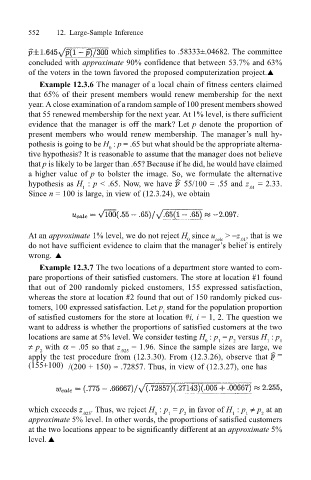Page 575 - Probability and Statistical Inference
P. 575
552 12. Large-Sample Inference
which simplifies to .58333±.04682. The committee
concluded with approximate 90% confidence that between 53.7% and 63%
of the voters in the town favored the proposed computerization project.!
Example 12.3.6 The manager of a local chain of fitness centers claimed
that 65% of their present members would renew membership for the next
year. A close examination of a random sample of 100 present members showed
that 55 renewed membership for the next year. At 1% level, is there sufficient
evidence that the manager is off the mark? Let p denote the proportion of
present members who would renew membership. The managers null hy-
pothesis is going to be H : p = .65 but what should be the appropriate alterna-
0
tive hypothesis? It is reasonable to assume that the manager does not believe
that p is likely to be larger than .65? Because if he did, he would have claimed
a higher value of p to bolster the image. So, we formulate the alternative
hypothesis as H : p < .65. Now, we have 55/100 = .55 and z = 2.33.
.01
1
Since n = 100 is large, in view of (12.3.24), we obtain
At an approximate 1% level, we do not reject H since u > −z , that is we
calc
0
.01
do not have sufficient evidence to claim that the managers belief is entirely
wrong. !
Example 12.3.7 The two locations of a department store wanted to com-
pare proportions of their satisfied customers. The store at location #1 found
that out of 200 randomly picked customers, 155 expressed satisfaction,
whereas the store at location #2 found that out of 150 randomly picked cus-
tomers, 100 expressed satisfaction. Let p stand for the population proportion
i
of satisfied customers for the store at location #i, i = 1, 2. The question we
want to address is whether the proportions of satisfied customers at the two
locations are same at 5% level. We consider testing H : p = p versus H : p 1
0
1
1
2
≠ p with α = .05 so that z .025 = 1.96. Since the sample sizes are large, we
2
apply the test procedure from (12.3.30). From (12.3.26), observe that =
(155+100) /(200 + 150) ≈ .72857. Thus, in view of (12.3.27), one has
which exceeds z .025 . Thus, we reject H : p = p in favor of H : p ≠ p at an
1
2
1
0
1
2
approximate 5% level. In other words, the proportions of satisfied customers
at the two locations appear to be significantly different at an approximate 5%
level. !

